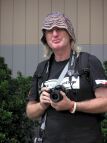What is documentary photography?
Documentary photography follows a single topic or story in-depth over time, as opposed to photojournalism’s real-time coverage of breaking news and events. By deepening our understanding and emotional connection to stories of injustice, documentary photography can capture and sustain public attention, and mobilize people around pressing social and human rights issues.Why is documentary photography important to an open society?
Images have the power to highlight stories that aren’t gaining sufficient traction and to amplify a diversity of perspectives. The Open Society Foundations support documentary photography as a vital tool that can help bring about social change. Visual storytelling exposes unseen or ignored realities, and can provide evidence of human rights violations.Can photography really inspire people to take action on social justice issues?
Tackling systemic issues—such as corruption and discrimination—is complex work that involves multiple actors and years of organizing, advocacy, or litigation. We believe that photographers can be more effective when connecting to those who are already working towards change in an ongoing way.For example, photographer Marcus Bleasdale has been documenting the consequences of natural resource exploitation in the Democratic Republic of the Congo since 2000. Human Rights Watch worked with Bleasdale to create a report and exhibition that eventually forced a Swiss company, Metalor Technologies, to stop buying Congolese gold in Uganda. As a result of these efforts and the work of other organizations, nearly $100 million in funding for warlords dried up overnight.
How do photographers document difficult situations while also respecting the dignity of the people they portray?
Effective documentary photographers work to develop strong relationships with and gain the trust of the people they photograph. They build this trust over time—by establishing their intentions upfront, engaging repeatedly with people and communities, and being open to having their assumptions challenged.Such efforts enable photographers to acquire a more nuanced understanding of the issues they document, see past generalizations and stereotypes, and become more sensitive to the cultural and political contexts in which they work. The best photographers represent people as a whole, avoid gratuitous and sensational imagery, and put safeguards in place to ensure that their documentation does not jeopardize the safety or security of the people they photograph.
What are the Open Society Foundations doing to support documentary photography?
Our Documentary Photography Project supports training, production, and audience engagement to strengthen photographers’ ability to advance human rights around the world in innovative ways.Through grants to leading organizations—such as the Market Photo Workshop—we support training for documentary photographers that connects their work to social justice efforts. Production is supported through organizations such as the Magnum Foundation and Aftermath Project, which provide grants to continue or create new projects.
We support work that bridges photography with advocacy through the Audience Engagement Grant, for collaborative projects designed to engage viewers to take action. Through programs such as Photography, Expanded—organized with the Magnum Foundation and New Arts Axis—we bring together photographers with interactive designers, programmers, social media experts, and activists to explore how digital tools and interactive platforms can mobilize people around urgent issues.
Our Moving Walls exhibit, which is on view at the Open Society Foundations New York headquarters and a few additional offices, showcases photographers documenting injustices as well as the struggles to overcome them.





